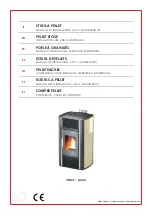
6
|
P a g e
E730 Defra instruction manual |
current as of May 2015
All information supplied by
Ecco Stove
TM
is a trade mark of Landy Vent UK Limited copyright©EccoStove2015
Ecco Stove
| Foster House
| 2 Redditch Road,
Studley,
B80 7AX, United Kingdom
T
| +44 (0)1527 857 814
E
W
| www.eccostove.com
Patent pending USA, Canada, Europe & Russia | UK Patent nos: 2467433 & 2498883
6. CLEAR GLASS OPERATION
Blackening of the door glass results from poor quality fuel (unseasoned wood) and too slow an initial
firing until the stove has reached its optimum working temperature.
Chimney draft if less than 0.06 inches water guage will impair the stove performance and hence its
capability to keep the door glass clean. Your installer will check this for you.
The whole stove body should be a minimum of 150 to 200˚C to enable the air wash to operate
satisfactorily on the inside of the glass face. (200˚C is the optimum operating temperature).
Do not load logs with the end grain pointing toward the glass as this will result in excessive glass
blackening. Always arrange the logs in a wigwam fashion within the firebox.
We cannot guarantee that
the stove glass will not blacken. However, high temperature (150˚C +) burning using the secondary air
control will clear the glass. (200˚C is the optimum operating temperature).
7. AIRATED BACK PLATE
The back panels (pre-drilled vermiculite
or ceramic panels at the rear of the stove) are consumables and
will deteriorate in use or may be broken. The panels are not covered by the manufacturer’s warranty
.
Damage can be caused by excessive firing but more usually by logs being smashed against them when
loading stove. Loading must be carried out with care.
8. ASH GRATE
The grate within your Ecco Stove is made from cast iron being a highly durable material providing a long
life; however, it is considered a consumable item and not covered by the manufacturer’s warranty. The
raised block on the grate is to be fitted to the back of the stove.
Ash removal is recommended before the grate bars become flooded with ash. The grate is easily
removed by simply lifting it out through the opened glass door.
9. ROPE SEALS
Regular maintenance of the stove is in part related to rope seals. Seals between the sections are factory
fitted and may remain in place without maintenance unless the appliance is stripped and moved, at
which time all compressive seals between sections must be replaced with like for like diameter rope or
flat tape as fitted to the stove at the time of its construction.







































